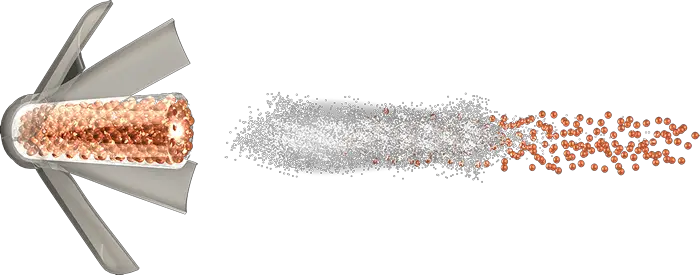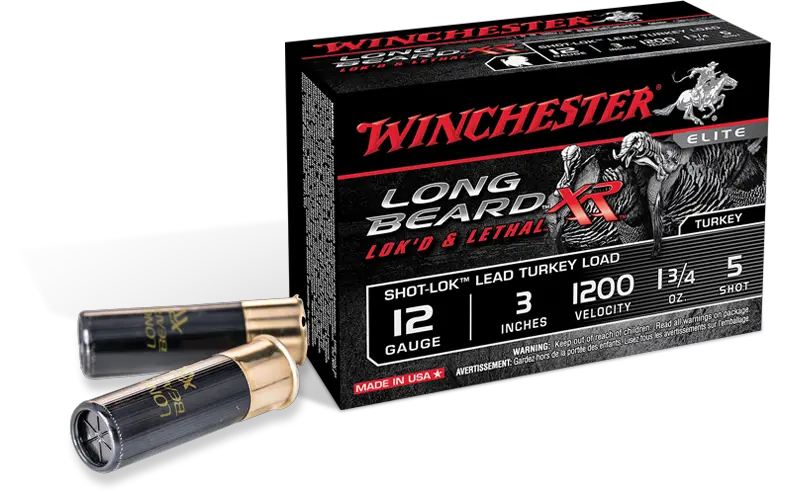Disclaimer: I have used my own money to buy every Long Beard XR shell I’ve ever used, though Winchester did once send me a box of waterfowl ammo to test. Carlson’s has provided me with chokes for testing, but I bought this one with my own money.
There are very few categories of hunting ammunition or gear where there is a very clear best-of-the-best product with no close second. In fact, I can only think of one, and that is Winchester’s Long Beard XR (Extreme Range) turkey hunting shotgun shells. I have done numerous ballistics gel tests and pattern tests, some of which I will link to, examining many of the best turkey loads on the market. And in the lead shotshell category, I have found the Long Beard XR to be second to none.
They have been my top turkey hunting load for almost every season I’ve been in the woods. This ammo review is not sponsored.
Why Winchester Long Beard XR?
I bought my first box of Winchester Long Beard XR for my second turkey hunting season ever. There were only two or three different kinds of turkey loads in the whole store and I bought a box of each. I did not realize that I had put in my cart the best lead turkey load ever produced in the history of the sport. It took me years to understand that the Long Beard XR was the best of the best and that there was no close runner up in the world of lead shotshells for turkey hunting. I also decided to buy a Carlson’s Long Beard XR Choke Tube to go along with it because it seemed the obvious choice. Those two haphazard marketing driven purchases would prove to have been some of the best hunting gear decisions I ever made.
Long Beard XR Features
I personally have a low tolerance for marketing hype and for something to impress me it needs to have clearly scientific and demonstrable properties. Ironically, I noticed those high performing properties before I even took the time to consider the marketed features of the Long Beard XR. Turns out, the features are rather impressive. There are three main things that this ammo brings to the table.
1) Copper Plated Lead. Copper plating improves lubricity which means the pellets can cut through the air and the target with less friction. This results in tighter patterns, more energy at range, and better penetration. People often ask by how much, and that is the right question. Answering it is hard because companies that use it don’t tend to make the same exact load but with unplated shot. But my preliminary testing shows maybe 5-10% improvement across the board for copper plated shot. I did a full article on the subject titled Why Is Shotgun Shot Copper Plated.
2) Shot-Lok Technology. Winchester uses a special resin to keep all of the pellets together but not bumping into each other as they go through the barrel and choke. This also prevents shot deformation from occurring in the barrel. The resin shatters when the shot is fired but it stays in place until the pellets leave the barrel and separate from the shot cup. I’ll be honest, I do not know of any way to test and see if its accurate or even possible for such a thing to make any difference. But what I do know is that the performance of these shells is outstanding, far beyond any lead shell I have yet tested against them.
3) Specially Designed Shot cup. Winchester does not advertise this much but the shot cup, or the wad, is obviously specially designed for this shell to work with the resin and the copper plated pellets. It holds everything together as it goes through the barrel and then releases perfectly allowing the pellets to fly unhindered at their target in a tight pattern.

The Marketed Performance
Winchester is sure to state how impressive the performance of these shells is. Their marketing summary is usually something similar to the following.
- Winchester’s most advanced turkey load – increased lethality at longer ranges
- Heavier-than-lead load performance at a fraction of the cost
- Shot-Lok Technology – increased shot stability for better downrange performance
- Devastating terminal on-target performance
- Tighter patterns – 2X the pellents in a 10″ circle up to 60 yards
- Deeper penetration and devastating knockdown at longer ranges
Now I have read a lot of similarly sounding marketing and I usually just shake my head at stuff like this. But after I started testing the Winchester Long Beard XR shells, I did a double take on the performance claims.
The Real Performance
So how good is the performance of the Long Beard XR really? Does it have double the pattern density in a 10″ circle? Yes, yes it does, and then some. Often it has triple the pattern density of other turkey loads all going through the same choke tube. All lead loads of course. TSS tungsten turkey shells are a whole different universe and those do perform better, and they should at 400% more cost on average. But in terms of lead, nothing is even close.
Do the Long Beards have deeper penetration? That is harder to test because an apples-to-apples comparison is very difficult to arrange. But even the #6s have all the penetration you could ever want at 40 yards. With about 170 pellets in a 10 in circle, the sheer impact force is going to be devastating. Does this ammo live up to the marketing? I am going to say yes. Here is a video where I tested 8 different random turkey loads that I was able to get my hands on, and some non-turkey loads just for fun. The results are impressive.
What Choke Is Best For The Long Beard XR?
I have tested the Long Beard XR out of a few turkey chokes at this point and by far the best choke I’ve used is the Carlson’s Long Beard XR Choke Tube. According to the marketing this choke was designed expressly for these shells. Now does that really amount to anything engineering wise, or is it just marketing? I am not certain. But what I am sure of is that this choke works good with these shells. It’s the best I’ve tested. So, whatever they have done, they have made sure that this choke is tuned nicely to this load. If I ever find a choke that works as good or better, I’ll come back to this post and add it in here.
What Shot Size Is Best?
They make the Winchester’s Long Beard XRin three different shot sizes, #6, #5, and #4. I did a test video on this very subject and the results were interesting. For every step up in shot size you gain about 15% more penetration but lose about 15% of the pellets on paper. So, the #6 has 30% more pellets and roughly 35% less penetration than the #4. And the #5 splits the difference and is in the middle.
So which is best? Well, in short you cannot go wrong with any of them. I think I prefer the #5 as the middle ground for long range hunting. The #6 is absolutely best for 40 yards and closer. Beyond 40 yards, I would want the #5 because it has a little more energy. I would prefer the extra pellets over the #4 myself. But like I said. You cannot go wrong with any of them.
Do You Need 3.5″ Shells?
If your gun shoots 3.5″ shells, your shoulder likes 3.5″ shells, and you think you gain an advantage with 3.5″ shells then by all means hunt with them. Personally, I don’t think the extra 1/4 of an ounce matters much. And I would NEVER buy another turkey gun just so I could use 3.5″ shells. I would rather shoot 3″ TSS shells. You would save a lot of money overall. But that said, the 3″ Long Beards are really all you need. I think for the average shooter they will shoot the lighter shells better and the gains from better shooting will exceed the gains from a few more pellets. But if you are a seasoned shooter and you have a gun that will fire them, more payload from a 3.5″ shell is more payload.
How Do They Work Hunting Turkeys?
This is all that really matters right? Well, it is, and it isn’t. I find people’s perception of how things work in the field is often skewed. One or two good or bad experiences and an opinion is stuck in their head regardless of any facts. From the previously mentioned data, you should already be able to tell how they work in the woods, and that is very well. But I since I was killing gobblers with the Winchester Long Beard XR before I ever did any ballistics gel tested anything, I can tell you also from experience that this stuff is potent.
If a turkey is within 40 yards and you can aim reasonably well, that turkey is dead. If the turkey is further than 40 yards and you can aim well, it is probably dead too. How far exactly can you take a turkey with the Long Beard XR? I have heard people quote all kinds of crazy ranges, so I am going to do some testing soon with long range shots. But suffice to say, it is the best lead turkey load on the market at any range. If you want more punch, you need to step up to some tungsten, here is an article I did on some: APEX TSS Turkey Hunting Ammo Review.
How Long Does The Ammo Last?
I hunted for years with the same box of Long Beard XR’s. Putting the shells in my gun, taking them out again, putting them in my vest, then back in the gun, and repeat over and over. I’d shoot one shell per year and repeat the process next year with the same handful of shells minus one. This subjects shells to moisture, vibrations, dirt, as well as general wear and tear. I never had one fail to shoot, fail to eject, or lose any noticeable level of performance. The words began to rub off the shell, but they seemed to last forever despite so much handling, year after year.
Final Analysis
The Winchester Long Beard XR is one of the few hunting shotgun loads that has truly impressed me. These days they cost about $2.50-$3.00 per shell. They may seem expensive but a box of 10 might last you for several years. And it is a fraction of the cost of TSS which does perform better but not that much better. Ultimately if you are hunting turkeys at regular ranges, you have no need to pay for tungsten turkey shot because you cannot kill the turkeys any deader inside of 40 yards than with the Long Beard XR.
I recommend these shells to all hunters, new, experienced, prospective, professional, etc. For the cost, there is no reason to ever shoot anything else at a turkey. They are the best lead load out there, and they are second only to TSS loads that cost $10+ a shell.
Be sure to listen to The New Hunters Guide Podcast and check us out on YouTube.
Till next time. God bless you, and go get em in the woods!
George Konetes Ph.D. – Founder and Host of the New Hunters Guide.
The New Hunters Guide is simply what George wishes he would have had when learning how to hunt; a single place to get practical hands on knowledge about different kinds of hunting, gear, strategy, and tips that can improve your comfort and fun factor in the woods.

